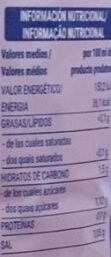Tinto de verano - Hacendado - 1.5 l
Aquesta pàgina del producte no està completa. Podeu ajudar a completar-la editant-la i afegint-hi més dades a partir de les fotos ja disponibles, o fent-ne més amb l'aplicació de androide o iPhone / iPad. Gràcies!
×
Codi de barres: 8480000678195 (EAN / EAN-13)
Nom comú: Bebida a base de vino con azúcar y edulcorantes
Quantitat: 1.5 l
Empaquetament: en:Bottle
Marques: Hacendado
Categories: Begudes, Begudes alcohòliques, Vins, Vi negre, en:Premixed alcoholic beverages, en:Wine-based alcoholic beverages, en:Wine-based drinks
Etiquetes, certificacions, premis:
Punt verd
Botigues: Mercadona
Països on es va vendre: Espanya
Matching with your preferences
Entorn
Petjada de carboni
Empaquetament
Transport
Report a problem
Fonts de dades
Producte afegit per kiliweb
Última modificació de la pàgina del producte per mmmaki.
La pàgina del producte, també editada per duhowpi, simone12, spotter, yuka.sY2b0xO6T85zoF3NwEKvllZLfOfVrx-fJSPiiWeXxYuePp_1a_VO8piqNas.








